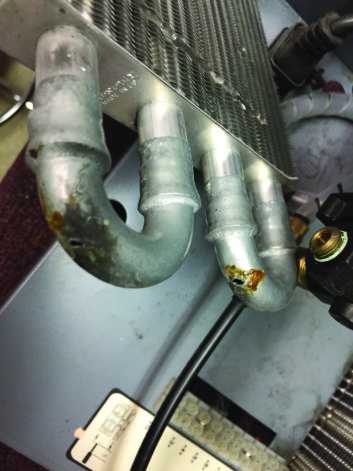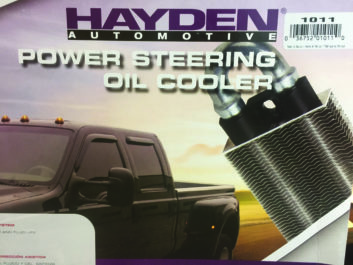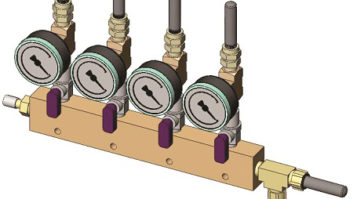
The internet is such a useful tool for today’s broadcast engineer. Here’s another case in point:
Bill Bowin is the chief engineer for North American Broadcasting Company in Columbus, Ohio. He relates that his assistant Dave Matthews picked up an Andrew dehydrator at the most recent Dayton Hamvention. Dave figured that even if the unit didn’t work, the price was right, even if just for spare parts.
After getting the dehydrator on the bench, the only problem Dave could find was that the cooling radiator had corroded, as seen in Fig. 1. Hoping to get the “radiator” repaired, Dave took it to the station’s resident car guru, who commented, “Hey, that’s an oil cooler!”

A quick search on Amazon revealed a virtually identical replacement for under $30. Fig. 2 is a picture of the actual box, including the part number. The replacement oil cooler fit perfectly in the dehydrator, which will now have a new home keeping a transmission line dry.
***
RW Editor-In-Chief Paul McLane occasionally passes on some great tips of his own.
This one is borrowed from the June 24 issue of PC Magazine. Because so many engineers use the Raspberry Pi computer, readers will be pleased to know that the new Raspberry Pi 4 laptop computer comes with three times the processing power of the previous generation. Plus, it has the capability to drive two 4k HDMI displays at once, as well as providing a Gigabit Ethernet port and offering USB 3.0 connectivity.
If you haven’t explored the Raspberry Pi, head to www.raspberrypi.org. For $35, you’ve got a full-fledged computer, and the site provides both tutorials and a number of projects.
If you’ve experimented with a Raspberry Pi in the past, another feature is this new version is backward-compatible. So, if you have older Raspberry Pi projects, this new version can be easily exchanged. What a concept!
Have you used the Raspberry Pi in a broadcast setting? Let our readers know about it. Send me your project information, along with high-resolution photos, to johnpbisset@gmail.com.
***
Frequent contributor and project engineer Dan Slentz sent another link for acoustic foam panels — this time from Home Depot. Dan writes that he is amazed how much “studio” gear is found on non-broadcast websites.
Go to www.homedepot.com, and enter Acoustic Panels in the search block. You’ll find a variety of acoustic panels by several manufacturers including Auralex. Are you looking for a non-foam sound diffuser? Enter “sound diffuser” in the search block and scroll down for a variety of products.
Of course, readers of Radio World should patronize our broadcast industry suppliers first, when all other things are relatively equal. A non-industry supplier may or may not be more expensive. Keep in mind too that Home Depot may have neither the range of options or the expertise to help you.
But a box store might help you out when you need something this minute. Remember, Radio Shack probably wasn’t your first choice in the old days if you needed a connector, cable or cheap mic. But it was comforting to know you had that option as a complement to your relationship with a favorite radio industry distributor.
***
Ham Brian Beezley (K6STI) commented on the Stellar Labs Yagi that we mentioned in a previous column. From his perspective and measurements, it lacks the tremendous directivity and forward gain promised by the manufacturer. Brian also questions whether it would survive a harsh winter, even though it is constructed of tubular and not rolled metal.
Brian modeled the antenna, and its performance, along with a suggested modification to improve the performance. His results can be found here: http://ham-radio.com/k6sti/stellar.htm.
Brian also modeled the performance of over 25 Yagis, and their individual performances can be compared here: http://ham-radio.com/k6sti/curves.htm.
As to the Stellar Labs product, Brian writes that its availability and low cost are perhaps the most valuable features.
***

In the previous column, I challenged readers to identify Fig. 4 (shown as Fig. 3 here). I noted that it was a commonplace in radio and TV stations but might be hard to find anymore.
These are adhesive labels that were used not just on file folders but to label audio tape cartridges, which we inserted into endless-loop cart machines to play back spots, jingles and music.
Ask a broadcasting veteran how much fun it was trying to scrape off all that adhesive when trying to remove the labels! (That was one of my first jobs in radio.)
By the way, I checked; Avery still manufactures these labels, just in case you need them for file folders — or that stack of carts in your basement! Head to www.avery.com and search for “file folder labels.”
Contribute to Workbench. Send Workbench tips and high-resolution photos to johnpbisset@gmail.com.
Author John Bisset has spent 50 years in the broadcasting industry and is still learning. He handles western U.S. radio sales for the Telos Alliance. He is SBE certified and is a past recipient of the SBE’s Educator of the Year Award.







